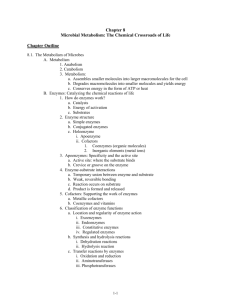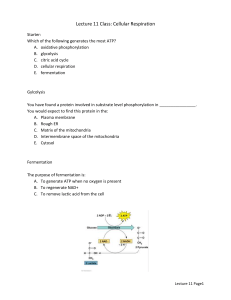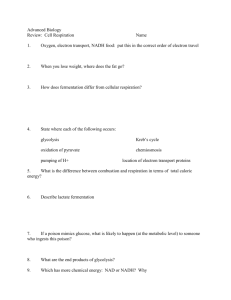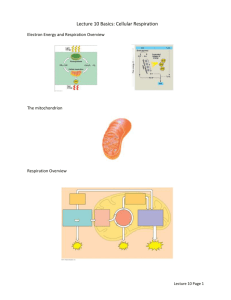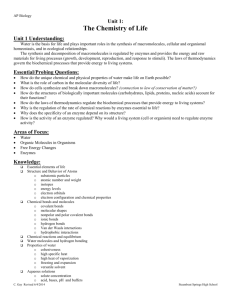1 Chapter 8 Microbial Metabolism: The Chemical Crossroads of Life
advertisement
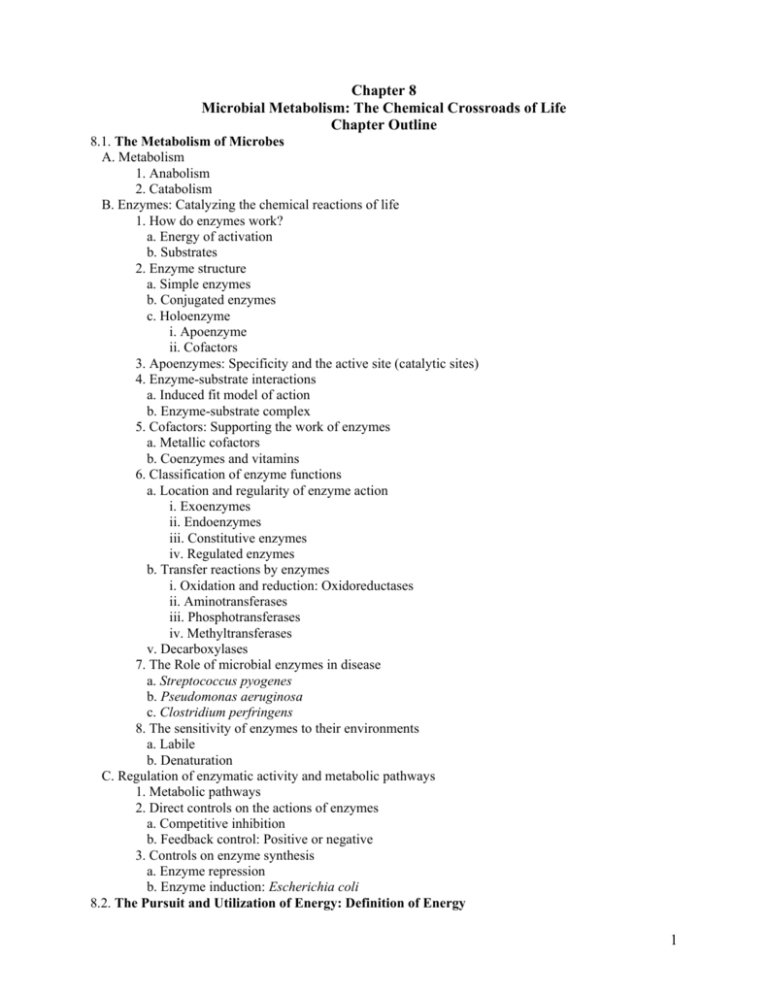
Chapter 8 Microbial Metabolism: The Chemical Crossroads of Life Chapter Outline 8.1. The Metabolism of Microbes A. Metabolism 1. Anabolism 2. Catabolism B. Enzymes: Catalyzing the chemical reactions of life 1. How do enzymes work? a. Energy of activation b. Substrates 2. Enzyme structure a. Simple enzymes b. Conjugated enzymes c. Holoenzyme i. Apoenzyme ii. Cofactors 3. Apoenzymes: Specificity and the active site (catalytic sites) 4. Enzyme-substrate interactions a. Induced fit model of action b. Enzyme-substrate complex 5. Cofactors: Supporting the work of enzymes a. Metallic cofactors b. Coenzymes and vitamins 6. Classification of enzyme functions a. Location and regularity of enzyme action i. Exoenzymes ii. Endoenzymes iii. Constitutive enzymes iv. Regulated enzymes b. Transfer reactions by enzymes i. Oxidation and reduction: Oxidoreductases ii. Aminotransferases iii. Phosphotransferases iv. Methyltransferases v. Decarboxylases 7. The Role of microbial enzymes in disease a. Streptococcus pyogenes b. Pseudomonas aeruginosa c. Clostridium perfringens 8. The sensitivity of enzymes to their environments a. Labile b. Denaturation C. Regulation of enzymatic activity and metabolic pathways 1. Metabolic pathways 2. Direct controls on the actions of enzymes a. Competitive inhibition b. Feedback control: Positive or negative 3. Controls on enzyme synthesis a. Enzyme repression b. Enzyme induction: Escherichia coli 8.2. The Pursuit and Utilization of Energy: Definition of Energy 1 A. Cell energetics 1. Exergonic 2. Endergonic B. A closer look at biological oxidation and reduction 1. Redox reactions 2. Phosphorylation and ATP synthesis 3. Electron transfer 4. Dehydrogenation 5. Electron carriers: Molecular shuttles a. NADH b. Final electron acceptor: Oxygen C. Adenosine triphosphate: Metabolic money 1. The molecular structure of ATP: Phosphate, sugar, and a base 2. How to make ATP a. Substrate-level phosphorylation b. Oxidative phosphorylation c. Photophosphorylation 8.3. Pathways of Bioenergetics A. Catabolism: An overview of nutrient breakdown and energy release 1. Glycolysis 2. Tricarboxylic acid cycle (Kreb’s cycle) 3. Respiratory chain: Electron transport and oxidative phosphorylation B. Energy strategies in microorganisms 1. Aerobic respiration a. Glycolysis: The starting lineup i. An anaerobic step ii. Pyruvic acid synthesis iii. Steps in the glycolytic pathway b. Pyruvic acid: A central metabolite c. The tricarboxylic acid cycle: A carbon and energy wheel i. The processing of pyruvic acid ii. Acetyl coenzyme A role iii. Role of NADH iv. Steps in the TCA cycle d. The respiratory chain: Electron transport and oxidative phosphorylation i. Elements of electron transport: The energy cascade ii. Formation of ATP and chemiosmosis iii. ATP synthase iv. Potential yield of ATPs from oxidative phosphorylation e. Summary of aerobic respiration i. The terminal step: Formation of water ii. Neisseria, Pseudomonas, Bacillus iii. Klebsiella, Enterobacter iv. Streptococcus v. Superoxide dismutase and catalase f. Alternate catabolic pathways C. Anaerobic respiration 1. E. coli 2. Pseudomonas and Bacillus 3. Denitrification D. The importance of fermentation E. Products of fermentation in microorganisms 2 1. Alcoholic fermentation 2. Acidic fermentation a. Streptococcus and Lactobacillus: Homolactic fermentation b. Leuconostoc: Heterolactic fermentation 3. Mixed acid fermentation: Propionibacterium 8.4. Biosynthesis and the Crossing Pathways of Metabolism A. The frugality of the cell: Waste not, want not 1. Amphibolic sources of cellular building blocks 2. Formation of macromolecules 3. Carbohydrate biosynthesis 4. Amino acids, and protein and nucleic acid synthesis 3
